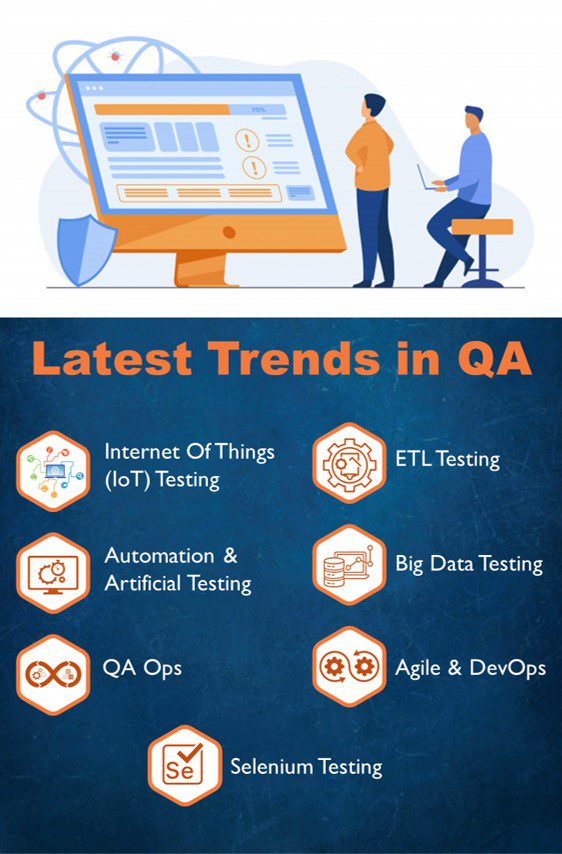Software Testing – End Of The Road?

- March 16, 2021
Is Software Testing here to stay or is the market over forever? The biggest challenge that any enterprise face is concerned with the new age technology and its compatibility with the old applications and software in the market. Technology is everchanging, but when the speed of this change boils down to every decade, the market sees a rapid decline and then sudden inclination towards these trends. So how to monitor a stable outcome for the sake of cutting-edge technology being compatible with older systems?
Let us find out!
There have been several industry-changing advancements in the technological ecosystem. Whether in the field of banking, healthcare, retail, or across other industries, the model of QA just illuminates those changes in a rapid yet calculated way. We often define QA being a definitive approach towards some qualified outcome for any software or application, hence it is a complex technical philosophy that also includes evaluation of a product idea, behavioral predictions, analysis of opportunities and threats, not just testing for bugs now are we?
Therefore, in retrospect of the conditions in which one becomes a QA, traditional testing in the scope of advanced technologies might seem far-fetched. A traditional approach is required, even though some may argue this case. So how to manifest that in the current era? Let us understand the current trends in QA!

Basis on this, we can now focus on how the testing environment helps in supplementing these trends.
EFFECTIVE DIGITAL QUALITY ASSURANCE
Techies have a saying, “Customer satisfaction defines a brand’s value”. While this is true in all aspects, customer satisfaction still remains ambivalent. In every aspect of Software Testing experience, the decision-making should be accurate and low risk-averse. The focus should always remain on the delivery of effective digital quality assurance for the companies either taking a service or working on a product.
BETTER DATA ANALYTICS
While developing software or an application that drives customer engagement, having precise customer data before or at the time of development is crucial. Earlier, the QA testers used to rely on the defects that were reported, the shortcomings of surveys, some feedbacks, and reviews of the customers. Suffice to say, the teams can directly access the customer’s data through Big Data- and AI-powered systems or other systems and test the software for a better-quality insight. With Agile/DevOps, digital QA testing teams can reduce the errors and shorten up the development cycle by drawing inferences from data sourced through Facebook, Twitter, web portals, digital assets, and web analytics, etc.
IMPROVISED CUSTOMER EXPERIENCE
While we can focus on the deliverables, any technological glitches drive the customer right out in search of an alternative. It is important to understand the customer requirement and work in adherence to that. When the company effectively understands the client’s model, work eases. It is often the case of misquoted requirements to the development team that in turn reduces the viability of the final output. Hence, it is important to reduce the risk of errors right in the ideation stage of the discussion. This in turn maximizes the customer experience a lot and helps in better client retention.
IMPROVED EFFICIENCY
It goes without saying that improving efficiency remains the most important aspect of the testing scope. From Manual to Automation Testing, the goal of the QA team remains to maintain efficiency in the best way possible. The outcome is unknown and uncontrolled. With delivery happening at a rapid pace, development teams have adopted rapid development techniques. It’s the need of the hour for QA teams to move away from traditionally pre-defined smoke/sanity/functional/regression test suites to the ones created dynamically using machine learning to identify high probability points of failures.
Testing is not limited to either manual or automation specifications. If only we can predict the outcome of our advancements. Every software or application is dependent upon its true lifecycle. Technical Evangelists argue that the average age of technology life is around 3-4 years. Hence, we have to understand the timeline where technologists have to improvise every 3-4 years on their skill-sets. This helps them to be at the top of the market and on top of their competitors. The market is cut-throat. No one gives a second chance if there is any failure in the delivery. Hence, an upgrade in technical skills remains a must.
Some would argue that in the realms of manual testing, automation testing led to a revolutionary change to diversify efficient results and eradicate common errors. Some may also put forth their beliefs in manual testing more than automation. For some, they have come to believe that automation is the doom of the century. Either way, it is evident that with the changing scope of technology in the ever-growing ecosystem of advanced applications and software, testing is here to stay.
